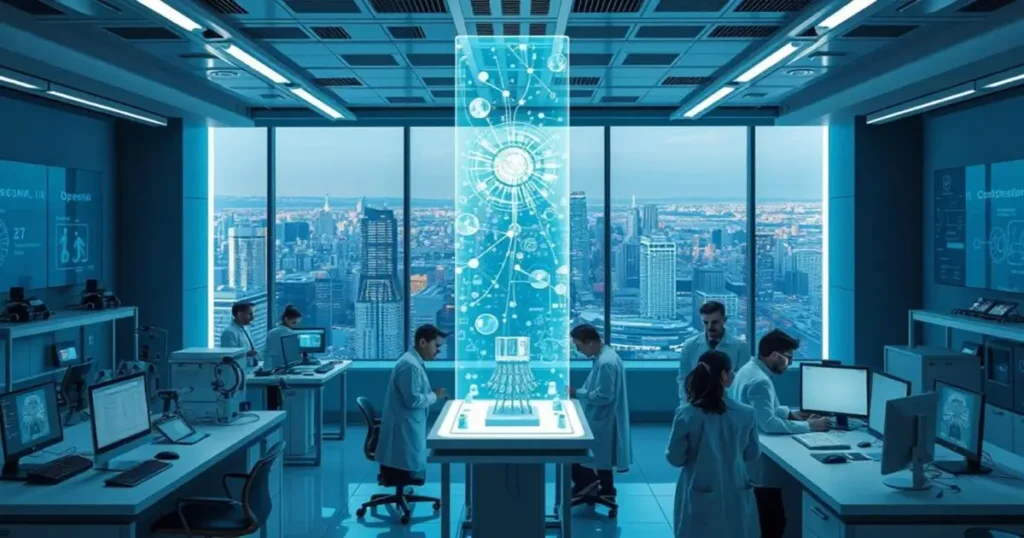OpenAI is leading the charge in artificial intelligence, pushing the limits of what’s possible. Our look into open AI news shows how it’s changing our world. With ChatGPT now used by over 300 million, OpenAI is a key player in tech.
The digital world is changing fast, thanks to AI. OpenAI is at the heart of this change, making tools that change industries and our abilities. They’re making a big impact on how we communicate, research, and solve problems.
We’re in a new era of AI, where language models are getting smarter and more flexible. OpenAI’s work is opening up new ways to learn and explore. Their technologies are helping us innovate and understand the world in new ways.
Table of Contents
GPT-4.5: OpenAI’s Latest Language Model Evolution
OpenAI has introduced GPT-4.5, a major step forward in AI chat. It was announced on February 27, 2025. This model brings new levels of conversation skills.
Enhanced Conversational Intelligence
GPT-4.5 can understand and answer complex questions better. It has 1.8 trillion parameters. This makes it top-notch in many areas:
- Multilingual proficiency across 14 languages
- MMLU benchmark score of 85.1%
- Reduced hallucination rate of 37.1%
- Improved SimpleQA accuracy at 62.5%
Breakthrough Reasoning Capabilities
GPT-4.5 is more than just a language model. OpenAI CEO Sam Altman says it feels like talking to a thoughtful person. It can give more detailed and accurate answers.
Performance and Accessibility
GPT-4.5 is first available through ChatGPT Pro for $200 a month. It’s much faster than before. It can handle 128,000 tokens and knows up to October 2024. This is a big step in AI.
Breaking New Ground: OpenAI’s Venture into Protein Engineering
OpenAI is exploring new territory in artificial intelligence. They are diving into protein engineering, using advanced ai text generation. Our team is finding new ways to change traditional science with these language models.
The company is using AI to solve biological problems. They are making big strides in protein design and cellular reprogramming. This is thanks to their sophisticated algorithms.
- Developing AI models for protein sequence generation
- Exploring stem cell research applications
- Creating novel protein engineering techniques
Recent breakthroughs show AI’s power in understanding biology. The GPT-4b micro model is a major achievement. It shows AI can suggest new ways to reengineer proteins.
Our research covers several areas:
- Improving protein stability
- Speeding up drug development
- Creating targeted treatments
AI is changing how we design proteins. What used to take months now takes weeks. This opens up new doors for regenerative medicine and biotechnology.
Understanding OpenAI’s Scientific Breakthrough in Cell Reprogramming
OpenAI has made big steps in combining artificial intelligence with biology. They’ve found a new way to make cells grow back using AI and advanced language skills.
This research is a big deal in cell reprogramming. It uses the GPT-4b micro model to change how we make stem cells. This shows how AI can solve tough scientific problems.
Yamanaka Factors and Stem Cell Potentials
We found out a lot about Yamanaka factors and how they help cells grow back. Key points include:
- Less than 1% of cells usually finish the rejuvenation process
- OpenAI’s model made precise changes in protein sequences
- Early tests show it’s 50 times more effective than old methods
GPT-4b Micro Model’s Innovative Applications
The GPT-4b micro model is a new way to work with proteins. It looks at protein sequences like sentences. Then, it suggests changes to make cells work better.
Collaboration with Retro Biosciences
OpenAI teamed up with Retro Biosciences, backed by $180 million. They want to explore how to live longer by improving cell reprogramming.
This breakthrough could change regenerative medicine. It offers hope for fixing age-related cell problems with AI and advanced language skills.
Open AI News: Latest Development and Industry Impact

The AI world is changing fast with OpenAI leading the way. Recent news shows big steps forward that are changing how we use technology.
OpenAI’s financial future looks bright with a possible $40 billion investment from SoftBank. This could make the company worth $260 billion. This investment shows that people believe in OpenAI’s future.
- SoftBank’s big investment shows OpenAI is a leader in AI
- OpenAI might build more data centers in 16 states
- This move puts OpenAI in a strong position in the AI race
But OpenAI is facing legal issues too. Lawsuits from the New York Times and others are a big challenge. These cases show how tricky it is to own rights in AI.
The mix of AI innovation and law is getting more complex. It brings both problems and chances for growth.
OpenAI has also overcome internal hurdles. The company has seen important people leave and set up a safety team. This shows OpenAI’s commitment to doing things right.
But OpenAI faces tough competition too. A Chinese startup, DeepSeek, is making waves by being cheaper than big names like OpenAI. This could change the AI world.
- DeepSeek briefly topped Apple’s App Store
- Being cheaper is a big challenge for big players
- AI competition is growing globally
As OpenAI keeps exploring new AI frontiers, everyone is watching closely. They see how these breakthroughs will change tech, business, and society.
The Evolution of OpenAI’s Language Models
OpenAI has led the way in changing ai language models. With each new generation, they’ve pushed the limits of artificial intelligence. Their journey shows a clear path of growth and improvement in language technology.
The move from GPT-3 to GPT-4.5 is a huge step forward. It shows big leaps in ai writing help and understanding language. Let’s look at the main points:
- 2018: GPT-1 launched with 117 million parameters
- 2019: GPT-2 grew to 1.5 billion parameters
- 2020: GPT-3 came out with 175 billion parameters
- 2023: GPT-4.5 “Orion” is the most advanced model now
Technical Advancements in AI Language Models
GPT-4.5 is a big win for natural language processing. It has better reasoning skills. This shows big improvements:
- Lower hallucination rates
- Better understanding of context
- Improved handling of different types of data
- Enhanced programming and reasoning
Future Development Roadmap
OpenAI keeps pushing the limits of ai language models. They aim to add advanced reasoning, better language understanding, and more efficient tools. These tools should handle complex human communication well.
The future of AI is not just about processing power, but about creating more intuitive and contextually aware language models.
OpenAI’s Research Methodology and Innovation Approach

OpenAI is leading the way in artificial intelligence. We’ve created a new way to work with natural language processing. Our method mixes new techniques with smart data analysis to improve AI.
Our research strategy has a few main points:
- Focused dataset training for precise model development
- Collaborative partnerships with industry leaders
- Iterative model refinement
- Advanced computational techniques
OpenAI has made big strides in AI research. We use deep learning to make our models very accurate. Our team works with top tech to train models that do complex tasks fast.
Our goal is to create AI systems that not only process information but truly understand and interpret complex concepts.
We’ve made tools that can handle huge datasets quickly. This cuts down research time and gives insights in many areas. Our focus is on making AI better and keeping it ethical.
Our research keeps getting better, keeping OpenAI at the forefront of AI. We’re always finding new ways to make intelligent systems better.
Competitive Landscape: OpenAI vs Other AI Leaders
The world of artificial intelligence is changing fast. Many big tech companies are racing to be the best in making AI talk and write like humans. Our study shows a mix of new ideas and strategic moves in AI across the globe.
Top players are exploring new AI areas, each with their own special skills:
- OpenAI leads in making big language models
- Google’s DeepMind is known for its research
- Meta works on open-source AI projects
- Chinese tech firms are becoming big players too
Comparing AI Technology Leaders
Our detailed market study gives us interesting views on the AI competition:
| Company | Market Share | Key Strengths |
|---|---|---|
| OpenAI | 9% | Advanced language models |
| Microsoft | 39% | Cloud AI integration |
| 15% | Machine learning expertise | |
| AWS | 19% | Scalable AI infrastructure |
Emerging Global Competitors
Chinese AI firms like Baidu are growing fast in AI chat tech. They invest a lot in AI that can handle text, speech, and images. This is a big challenge to the old leaders from the West.
The market for AI that can create content has grown a lot. It went from $191 million in 2022 to over $25.6 billion in 2024. This shows how fast and competitive AI technology is getting.
Commercial Applications and Industry Partnerships
OpenAI is changing the game with smart partnerships and AI writing tools. Our tech is making big changes in many industries.
The latest ChatGPT updates have opened up new chances for businesses. Now, companies can use advanced AI in new ways. This is a big change in how AI is used in business.
- Enhancing customer service interactions
- Streamlining content creation processes
- Developing personalized user experiences
- Automating complex workflow tasks
Our partnerships show great promise in many fields. For example, SoftBank Group Corp. is investing $3 billion a year in OpenAI. They want to use AI to automate over 100 million tasks.
| Partner | Investment | Key Focus |
|---|---|---|
| SoftBank | $3 billion | Workflow Automation |
| Bertelsmann | Enterprise Integration | Media & Services AI |
Bertelsmann’s partnership with us shows how companies are getting into AI. They’re using ChatGPT Enterprise to make things more efficient. This helps with many tasks, from writing to finding content.
The future of AI in business looks bright. Companies see how AI can help them innovate and work better.
Ethical Considerations and Safety Measures in OpenAI Development
AI technology is growing fast, bringing new challenges in how we develop it responsibly. OpenAI shows a deep commitment to ethics and safety in AI and tech breakthroughs.
Responsible AI Development Practices
OpenAI is taking steps to handle risks in advanced AI systems. They focus on being open and accountable through several ways:
- They test AI systems carefully to avoid bias.
- They use diverse data to make AI fair.
- They talk openly about AI’s impact on society.
Privacy and Security Protocols
Keeping user data safe and systems secure is key for OpenAI. Language understanding technologies are improved to stop misuse and protect privacy.
“Our commitment is to create AI that serves humanity ethically and responsibly” – OpenAI Research Team
Regulatory Compliance Measures
OpenAI works closely with policymakers and experts in AI. They know setting clear rules is vital to balance innovation with ethics.
Recent changes show the challenges in managing OpenAI breakthroughs while keeping ethics strong. This includes the team’s change and the new safety committee.
Conclusion
Our look into OpenAI shows a world of fast-paced tech growth. The company started as a nonprofit in 2015 and now is a huge player in AI. It has received over $6.6 billion in investments and trained its AI on 3.7 billion pages of data.
OpenAI’s partnerships, like the one with Microsoft, show the economic side of AI. Even with UK investigations, OpenAI keeps innovating. Their Stargate Project aims to spend $500 billion on data centers and infrastructure.
Looking ahead, OpenAI leads in AI tech. They’re working on new AI models and thinking about ethics. This could change many fields, from science to journalism.
OpenAI’s story shows how fast tech can change. With smart planning, lots of money, and new research, they’re pushing AI’s limits. Their work shows they’re not just making tech, but changing how humans and machines interact.